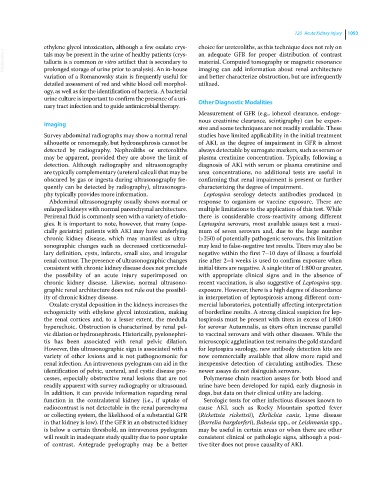Page 1155 - Clinical Small Animal Internal Medicine
P. 1155
120 Acute Kidney Injury 1093
ethylene glycol intoxication, although a few oxalate crys- choice for ureteroliths, as this technique does not rely on
VetBooks.ir tals may be present in the urine of healthy patients (crys- an adequate GFR for proper distribution of contrast
material. Computed tomography or magnetic resonance
talluria is a common in vitro artifact that is secondary to
prolonged storage of urine prior to analysis). An in‐house
and better characterize obstruction, but are infrequently
variation of a Romanowsky stain is frequently useful for imaging can add information about renal architecture
detailed assessment of red and white blood cell morphol- utilized.
ogy, as well as for the identification of bacteria. A bacterial
urine culture is important to confirm the presence of a uri- Other Diagnostic Modalities
nary tract infection and to guide antimicrobial therapy.
Measurement of GFR (e.g., iohexol clearance, endoge-
nous creatinine clearance, scintigraphy) can be expen-
Imaging
sive and some techniques are not readily available. These
Survey abdominal radiographs may show a normal renal studies have limited applicability in the initial treatment
silhouette or renomegaly, but hydronephrosis cannot be of AKI, as the degree of impairment in GFR is almost
detected by radiography. Nephroliths or ureteroliths always detectable by surrogate markers, such as serum or
may be apparent, provided they are above the limit of plasma creatinine concentration. Typically, following a
detection. Although radiography and ultrasonography diagnosis of AKI with serum or plasma creatinine and
are typically complementary (ureteral calculi that may be urea concentrations, no additional tests are useful in
obscured by gas or ingesta during ultrasonography fre- confirming that renal impairment is present or further
quently can be detected by radiography), ultrasonogra- characterizing the degree of impairment.
phy typically provides more information. Leptospira serology detects antibodies produced in
Abdominal ultrasonography usually shows normal or response to organism or vaccine exposure. There are
enlarged kidneys with normal parenchymal architecture. multiple limitations to the application of this test. While
Perirenal fluid is commonly seen with a variety of etiolo- there is considerable cross‐reactivity among different
gies. It is important to note, however, that many (espe- Leptospira serovars, most available assays test a maxi-
cially geriatric) patients with AKI may have underlying mum of seven serovars and, due to the large number
chronic kidney disease, which may manifest as ultra- (>250) of potentially pathogenic serovars, this limitation
sonographic changes such as decreased corticomedul- may lead to false‐negative test results. Titers may also be
lary definition, cysts, infarcts, small size, and irregular negative within the first 7–10 days of illness; a fourfold
renal contour. The presence of ultrasonographic changes rise after 2–4 weeks is used to confirm exposure when
consistent with chronic kidney disease does not preclude initial titers are negative. A single titer of 1:800 or greater,
the possibility of an acute injury superimposed on with appropriate clinical signs and in the absence of
chronic kidney disease. Likewise, normal ultrasono- recent vaccination, is also suggestive of Leptospira spp.
graphic renal architecture does not rule out the possibil- exposure. However, there is a high degree of discordance
ity of chronic kidney disease. in interpretation of leptospirosis among different com-
Oxalate crystal deposition in the kidneys increases the mercial laboratories, potentially affecting interpretation
echogenicity with ethylene glycol intoxication, making of borderline results. A strong clinical suspicion for lep-
the renal cortices and, to a lesser extent, the medulla tospirosis must be present with titers in excess of 1:800
hyperechoic. Obstruction is characterized by renal pel- for serovar Autumnalis, as titers often increase parallel
vic dilation or hydronephrosis. Historically, pyelonephri- to vaccinal serovars and with other diseases. While the
tis has been associated with renal pelvic dilation. microscopic agglutination test remains the gold standard
However, this ultrasonographic sign is associated with a for leptospira serology, new antibody detection kits are
variety of other lesions and is not pathognomonic for now commercially available that allow more rapid and
renal infection. An intravenous pyelogram can aid in the inexpensive detection of circulating antibodies. These
identification of pelvic, ureteral, and cystic disease pro- newer assays do not disinguish serovars.
cesses, especially obstructive renal lesions that are not Polymerase chain reaction assays for both blood and
readily apparent with survey radiography or ultrasound. urine have been developed for rapid, early diagnosis in
In addition, it can provide information regarding renal dogs, but data on their clinical utility are lacking.
function in the contralateral kidney (i.e., if uptake of Serologic tests for other infectious diseases known to
radiocontrast is not detectable in the renal parenchyma cause AKI, such as Rocky Mountain spotted fever
or collecting system, the likelihood of a substantial GFR (Rickettsia rickettsii), Ehrlichia canis, Lyme disease
in that kidney is low). If the GFR in an obstructed kidney (Borrelia burgdorferi), Babesia spp., or Leishmania spp.,
is below a certain threshold, an intravenous pyelogram may be useful in certain areas or when there are other
will result in inadequate study quality due to poor uptake consistent clinical or pathologic signs, although a posi-
of contrast. Antegrade pyelography may be a better tive titer does not prove causality of AKI.

